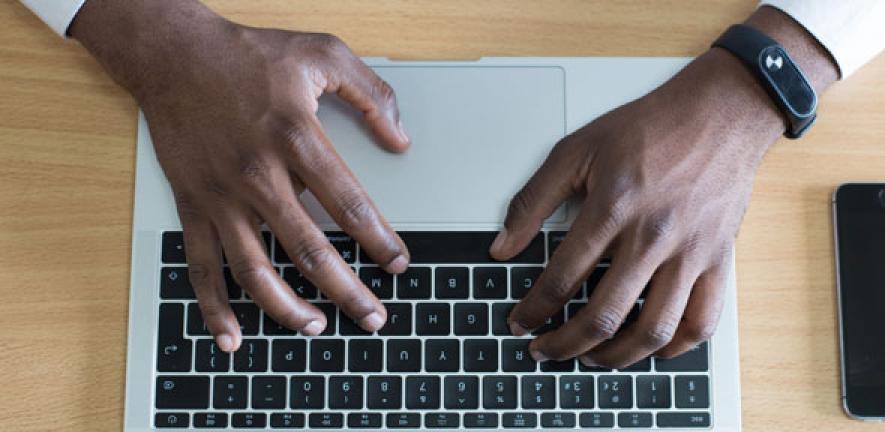
The largest-ever dataset on typing speeds and styles, based on 136 million keystrokes from 168,000 volunteers, finds that the fastest typists not only make fewer errors, but they often type the next key before the previous one has been released.
The largest-ever dataset on typing speeds and styles, based on 136 million keystrokes from 168,000 volunteers, finds that the fastest typists not only make fewer errors, but they often type the next key before the previous one has been released.
Crowdsourcing experiments that allow us to analyse how people interact with computers on a large scale are instrumental for identifying solution principles for the design of next-generation user interfaces.
Per Ola Kristensson
The data was collected by researchers from Aalto University in Finland and the University of Cambridge. Volunteers from over 200 countries took the typing test, which is freely available online. Participants were asked to transcribe randomised sentences, and their accuracy and speed were assessed by the researchers.
Unsurprisingly, the researchers found that faster typists make fewer mistakes. However, they also found that the fastest typists also performed between 40 and 70 percent of keystrokes using rollover typing, in which the next key is pressed down before the previous key is lifted. The strategy is well-known in the gaming community but has not been observed in a typing study. The results will be presented later this month at the ACM CHI Conference on Human Factors in Computing Systems in Montréal.
“Crowdsourcing experiments that allow us to analyse how people interact with computers on a large scale are instrumental for identifying solution principles for the design of next-generation user interfaces,” said study co-author Dr Per Ola Kristensson from Cambridge’s Department of Engineering.
Most of our knowledge of how people type is based on studies from the typewriter era. Now, decades after the typewriter was replaced by computers, people make different types of mistakes. For example, errors where one letter is replaced by another are now more common, whereas in the typewriter era typists often added or omitted characters.
Another difference is that modern users use their hands differently. “Modern keyboards allow us to type keys with different fingers of the same hand with much less force than what was possible with typewriters,” said co-author Anna Feit from Aalto University. “This partially explains why self-taught typists using fewer than ten fingers can be as fast as touch typists, which was probably not the case in the typewriter era.”
The average user in the study typed 52 words per minute, much slower than the professionally trained typists in the 70s and 80s, who typically reached 60-90 words per minute. However, performance varied largely. “The fastest users in our study typed 120 words per minute, which is amazing given that this is a controlled study with randomised phrases,” said co-author Dr Antti Oulasvirta, also from Aalto. “Many informal tests allow users to practice the sentences, resulting in unrealistically high performance.”
The researchers found that users who had previously taken a typing course actually had a similar typing behaviour as those who had never taken such a course, in terms of how fast they type, how they use their hands and the errors they make - even though they use fewer fingers.
The researchers found that users display different typing styles, characterised by how they use their hands and fingers, the use of rollover, tapping speeds, and typing accuracy.
For example, some users could be classified as ‘’careless typists’’ who move their fingers quickly but have to correct many mistakes; and others as attentive error-free typists, who gain speed by moving hands and fingers in parallel, pressing the next key before the first one is released.
It is now possible to classify users’ typing behaviour based on the observed keystroke timings which does not require the storage of the text that users have typed. Such information can be useful for example for spell checkers, or to create new personalised training programmes for typing.
“You do not need to change to the touch typing system if you want to type faster,” said Feit. “A few simple exercises can help you to improve your own typing technique.”
The anonymised dataset is available at the project homepage: http://userinterfaces.aalto.fi/136Mkeystrokes/
Reference:
Dhakal, V., Feit, A., Kristensson, P.O. and Oulasvirta, A. 2018. 'Observations on typing from 136 million keystrokes.' In Proceedings of the 36th ACM Conference on Human Factors in Computing Systems (CHI 2018). ACM Press.
Adapted from an Aalto University press release.
Want to type faster?
- Pay attention to errors, as they are costly to correct. Slow down to avoid them and you will be faster in the long run.
- Learn to type without looking at fingers; your motor system will automatically pick up very fast ‘’trills’’ for frequently occurring letter combinations (“the”), which will speed up your typing. Being able to look at the screen while typing also allows you to quickly detect mistakes.
- Practice rollover: use different fingers for successive letter keys instead of moving a single finger from one key to another. Then, when typing a letter with one finger, press the next one with the other finger.
- Take an online typing test to track performance and identify weaknesses such as high error rates. Make sure that the test requires you to type new sentences so you do not over-practice the same text.
- Dedicate time to practice deliberately. People may forget the good habits and relapse to less efficient ways of typing.

The text in this work is licensed under a Creative Commons Attribution 4.0 International License. For image use please see separate credits above.




